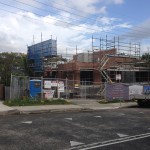DATA NEWS We love data!
Why property developers are on dangerous ground
Everyone said it would happen but no one believed them! Sydney home prices in November fell in their biggest retreat in five years as a regulatory crackdown forced banks to tighten lending and increase mortgage rates.
The values on total Sydney dwelling values dropped 1.4 percent from a month earlier, according to data from property researcher CoreLogic RP Data. Prices did fall back in May, but this was the biggest drop since December 2010.
In total prices across the nation’s capital cities declined 1.5 percent; with Melbourne leading with a 3.5 per cent decrease, Hobart down 2.4 per cent, Darwin 1.3 per cent and Canberra 0.5 per cent while Adelaide improved 0.7 per cent, as did Brisbane 0.6 per cent and Perth up 0.3 per cent.
Now before everyone in starts running around yelling ‘the sky is falling’ please consider that Sydney prices are up 44 percent in the past three years!
So how far could prices fall? According to AFR property guru Robert Harley if the downturn is conformed by another quarter of falling values we should look at the history of property cycles. In 2004, after the first boom of the new century, Sydney dwelling values fell 8.2 per cent in 21 months, using CoreLogic numbers. In the wake of the financial crisis, the fall was 6.2 per cent in 10 months; and in 2011-12 values fell 5 per cent in 18 months.
Some respected industry players say that next year will see a much more modest, say 2-3 per cent increase in both Sydney and Melbourne, but I believe that will depend on the area. Last week the lower auction clearance rate in Sydney’s eastern suburbs was 73 per cent, but in the south-west of the city the figure was 31 per cent and on the Central Coast, 48 per cent.
There is no doubt that parts of Sydney will continue to demand premium pricing, but the overall market is cooling and has been since the banks were ordered to pull their heads in and limit the amount of credit being offered to property investors which had begun to distort the market.
They responded by lifting interest rates on owner-occupier mortgages out-of-cycle, which also sent a chill through the market. More recently they have trimmed deposit rates.
Now the question is how long will it take for lower demand to impact on property construction industry. The latest figures showed dwelling approvals lifting 3.9 per cent in October, underpinned by large-scale apartment building.
According to CommSec this means home building is racking up some extraordinary numbers. Over the past year a record 233,180 new homes were approved – a boom it believes will continue to support economic activity over the next 12-18 months. Their conclusion is that increased supply should result in a much more balanced housing sector – as demonstrated by the pullback in home prices in five of the eight capital cities.
dbdata believes that the untold part of this story is that those developers in Melbourne, but more probably Sydney because of higher cost structures, should be rushing to get their projects underway and/or completed. The alternative is to consider shutting up shop and waiting for the next cycle. Tighter credit and waning demand mean that the last players in will be the first to collapse.


